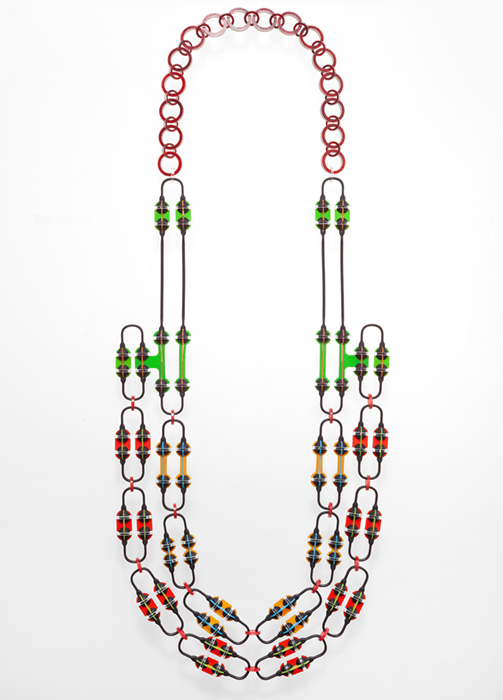German artist Svenja John’s work is characterized by her preference for the precision of computer-controlled techniques. Since 1994, she has been using Macrolon®, a polycarbonate that is widely used in the automotive industry, which she cuts into intricate elements using CAD (computer aided design) technology. But necklaces like this one called Uluru, produced using the most up-to-date industrial methods, are not a rejection of the handmade, or the specialist skills of the artisan. Water jet cutting and selective laser sintering (which builds forms up by binding a powdered material with lasers) create forms that are processed and colored and finished using traditional handcraft. As John puts it, ‘I do not use synthetic material in a decorative way or as a cheap substitute. Rather, I try to understand synthetic material for its own advantageous properties and its unique character. Synthetic material can be colourful and garish, luminously transparent or gracefully translucent. It can be sleek and cold or with fine pores and buffed.’ The necklace, an adornment with a long history, finds a contemporary form with modern industrial methods and materials. Svenja John lives and works in Berlin. She graduated from the goldsmith’s school in Hanau, Germany, in 1989, receiving a Master’s Diploma from the Staatliche Zeichenakademie Hanau in 1993. Her work is featured in the collections of the Museum of Art and Design and the Cooper Hewitt Smithsonian Design Museum, both New York City, the National Gallery of Australia in Canberra, and various institutions in Germany and Europe. Most recently her work was featured in the 2018 exhibition Future Form at the CODA Museum in Apeldoorn, the Netherlands.

Svenja John
ULURU
2018
Macrolon, nylon 3D-printed, and finest pigment acrylic paint
18 1/8 inches long